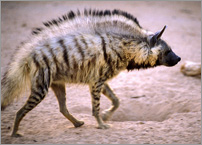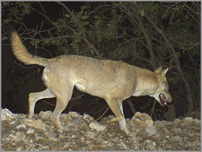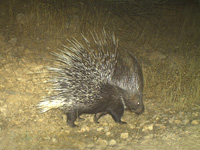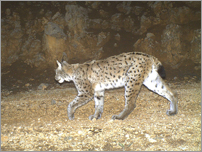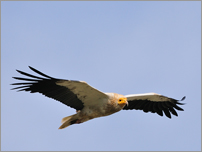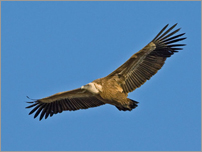WILDLIFE
Because of its being a geographical corridor and its mild winters, the Botan Valley retains a rich wildlife. One of the most rare species of Turkey, the striped hyena is known to use Botan regularly. Moreover the leopard, which was believed to be extinct in Turkey in 1970s, was discovered in 2010 at Gabar Mountain in the south of Botan Valley.
Striped hyena Hyaena hyaena
It is the sole species of Hyaenidae in Asia. Smaller than other members of the family, the striped hyena was used to be very common in many parts of Turkey. Now however, it forms highly fragmented populations being the largest in Southeastern Turkey. Known as heftar in the region, the hyena is widely distributed in the Botan Valley. The main reason is because of animal husbandry. All livestock losses are good food source for the species.
Wolf Canis lupus
Although it is the most common species of the Canidae, the wolf is endangered in many countries. Many wolf populations have become extinct in continental Europe and America. The species is however still widely distributed in Turkey and is common at Botan Valley due to animal husbandry practices.
Porcupine Hystrix indica
While the porcupine is mostly common in the Mediterranean region, it is also found in parts of Southeastern Turkey. Known as "sikhor" in the region, it was long believed that porcupines had the ability to project their quills to a considerable distance at an enemy, but this has since been proven to be untrue. When threatened, they shake their body and move their quills which they reach up to 50 cm lenght. Although they are common in whole southeast, as well as in Botan Valley, they are hard to see as they are nocturnal.
Eurasian lynx Lynx lynx
It is the second largest cat in Turkey after the leopard. Although its presence in southeastern Turkey could not be proven for decades, the first hard evidence was revealed in 2014. While it is a small cat, it has vital roles as the large cats (e.g. leopard, tiger) in the ecosystems because its ability to hunt big game (e.g. wild goat). It is known to use the Botan Valley as a wildlife corridor.
Egyptian vulture Neopron percnopterus
Named also as pharaoh's chicken, the species is the sole member of the Neophron genus in the Accipitridae family. It is the smalled vulture species in Turkey and Europe. Its body lenght is 60-70 cm with a wingspan of 155-180 cm. Its body and wings are white colored whereas its flight feathers in the wings are black. Egyptian vultures feed mainly on carrion but are opportunistic and will prey on small mammals, birds, and reptiles.
Griffon vulture Gyps fulvus
The griffon vulture is a large Old World vulture in the bird of prey family Accipitridae. It is also known as the Eurasian griffon. Its body size is 93–122 cm long with a 2.3–2.8 m wingspan. it is a typical Old World vulture in appearance, with a very white head, very broad wings and short tail feathers. It has a white neck ruff and yellow bill. The buff body and wing coverts contrast with the dark flight feathers. Like other vultures, it is a scavenger, feeding mostly from carcasses of dead animals which it finds by soaring over open areas, often moving in flocks. Because they consume carcasses, they prevent the outspread of diseases to other species.


